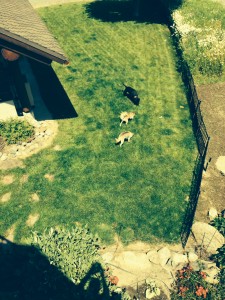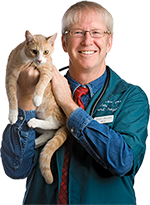 How is a dog owner’s lawn like a strip mall?
How is a dog owner’s lawn like a strip mall?
When I used to scout strip centers locations for potential veterinary hospitals, you could tell how busy the mall was even when it was closed just by looking at the oil stains in the parking lot. A plethora of fresh oil marks meant the retail area had a lot of traffic, and would be a good spot for a vet clinic.
Well, you can also tell if someone has dogs just by looking at the yard. A few small brown spots typically means one petite canine, whereas when the yard is covered with overlapping big brown splotches, it’s probably a multi-dog family.
While its acidity usually gets the blame, it’s actually the high concentration of nitrogen in normal, healthy dog urine that kills the grass. In lower concentrations, nitrogen is a fertilizer. That’s why you’ll often see a darker green ring of lush grass at the edges of the dead circle in the middle.
As you can see from the accompanying photo, our lawn looks like a cross between “Fifty Shades of Green” and a dartboard for a game played with urine, because we have four dogs of different sizes using the backyard to paint their Grrrembrant.
Can you protect your lawn from those dreaded rings of scalded grass? First, here are a few things that are frequently suggested but that are bad ideas:
- Don’t give your dog extra salt. The logic behind this is that excess salt will make a dog thirsty, so he’ll drink more, thus diluting his urine. The problem is, excess salt is as bad for your dog as it is for you — and for dogs with some health conditions, it’s deadly!
- Don’t give your dog tomato juice, vitamin C and other commercial products to acidify the urine. As I said, it’s the nitrogen in the urine, not the urine’s pH, that causes the scald.
- Don’t get your hopes up about topical treatments like applying gypsum to urine-scalded areas in the spring and fall. Even if you change the color of the grass in the treated areas, you still won’t get the uniform green color most people seek in a lawn.
To reduce brown spots, follow your dog around whenever she goes out, and immediately hose down the spot where she did her business. This will dilute the nitrogen in the urine, hopefully enough to prevent scalding.
You can also consider planting a lawn of clover instead of grass, as clover is highly resistant to urine scalding.
Truly eliminating brown spots in your lawn is as hard as finding an honest politician, but there’s one trick that will work: Designate a non-lawn area of the yard, such as a gravel, sand, or mulch area as the potty spot.
Or adopt the attitude we have here at Almost Heaven Ranch. Just like wearing pet hair on our clothes or having images of pets as a our mobile phone’s screensaver, dartboard-lawns are a visible sign of pet ownership and affection. We’re proud that our yard looks like somebody was hovering over the grass in a helicopter and shooting paintballs at it.
Whatever color of paint is in your dog’s palette, prevent it, enjoy it, or ignore it.

